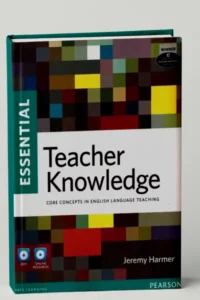Essential Teacher Knowledge (ETK) is written for people around the world who teach (or are going to teach) English. We have designed it to be useful to teachers of adults, teenagers and young learners – whether they are teaching general English or CLIL.
Essential Teacher Knowledge (ETK) is especially useful (but not only) for teachers who have English as a second language.
Essential Teacher Knowledge
Written in direct, accessible English, Essential Teacher Knowledge is a foundation level course for teachers of General English, Young Learners and CLIL (Content and Language Integrated Learning). It is appropriate for people who are studying for the Teaching Knowledge Test (TKT)
The information you need to understand the pedagogy and skills used in ELT:
- Teach English as a Foreign Language to students of all ages.
- Learn about the lives of different EFL teachers around the world.
- Prepare for the Teacher Knowledge Test (TKT) or other ELT tests.
What is in Essential Teacher Knowledge?
- ETK has 110 units about the English language and about how to teach it. The units describe practical classroom ideas as well as the ideas (the theory) behind them.
- There is an accompanying DVD. You can watch examples of teachers at work, and you can hear teachers from around the world talking about how they do things.
- We have divided ETK into separate sections so that it is easier to use. For example, if you want to improve your knowledge of English grammar, vocabulary, pronunciation, or text and discourse (the ‘nuts and bolts’ of the language), then you can look at the units in Section A. If, however, you are thinking of teaching CLIL (content and language integrated learning), then you will be more interested in Secti.on G. Teachers who work (or Thill work) with young learners will find Section F especially relevant.
- • However, many of the topics that we deal with are important in more than one area. Topics such as planning matter whether you teach adults, teenagers or children. As a result, there are units on planning in general (Units 79 and 80); there is a unit (100), on using topics and themes for planning young learner lessons; and we discuss planning for CLIL in Unit 109.
- Most of the unit topics in Section D (Managing learning and teaching) are just as relevant for teaching children and teenagers as they are for teaching adults. They will be just as interesting for CLIL teachers as they are for anyone else!
- When you are reaillng ETK you will often see technical terms written like this: PAIRWORK. This means that you can find the word in the Glossdex (pages 257-287). The Glossdex entry for pairwork looks like this (the numbers are the unit numbers in which pairwmk is mentioned): pair, pairwork when two students work together-+ 22, 26, 39, 42, 46, 56, 58, 67, 79, 86, 89, 93, 102, 107, 109.
- We give references to help you move around the book. For example, in Unit 43 (on motivation) you will find this: extensive reading -+5 4. This means that if you go to Unit 54, you will find more information about extensive reading.
How to use Essential Teacher Knowledge?
You can use the uits in ETK in any way you choose, of course. However, we have some suggestions about how the book can be most effective.
- You can choose the section that is most relevant to you and read the units in that section.
- You can look at the Contents list and choose the units that sound interesting to you.
- You can follow the references between the units (such as extensive reading -+5 4, mentioned above).
- You can look at the Glossdex and search for topics that interest you. For example, if you are interested in pairwork, you can follow up all the unit references that you find there to learn a lot about the use of pairwork in a variety of different contexts.
- You can watch the film clips on the DVD in any sequence that you want.


